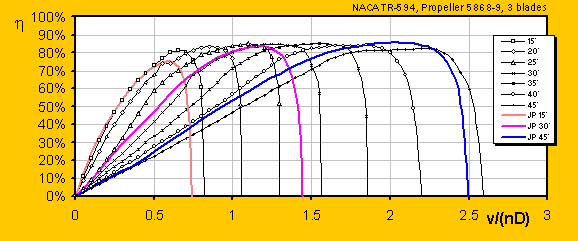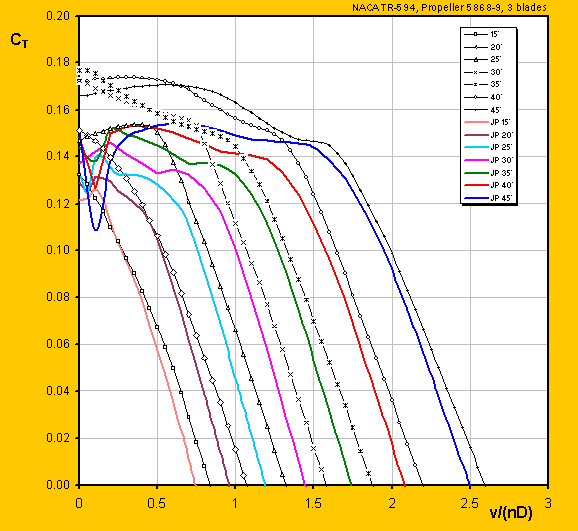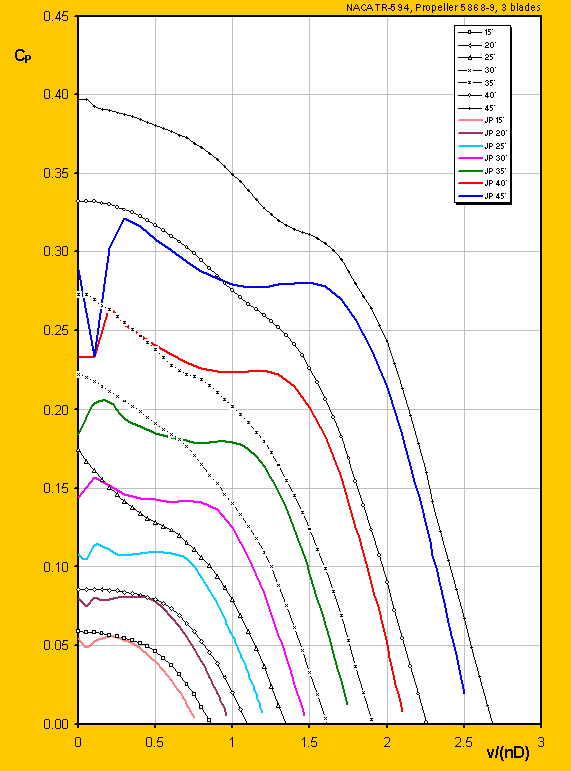
A Validation Exercise |
JavaProp is a fast and easy to use tool. Therefore we cannot expect it to model all phenomena occurring in the real world. The underlying method is limited when flow separation occurs e.g. at static conditions. Also JavaProp comes with a set of airfoil polars which can only represent a limited model of the whole range of possible airfoil sections.
Finally the flow field around a a propeller is fully three dimensional and quite complex with boundary layers, Mach number effects and local flow separation - this is even difficult to model accurately with the today's most sophisticated tools like Navier-Stokes solvers - which typically required you to wait for an answer some days or even weeks. JavaProp on the other hand can give you a first answer in fractions of a second bit at the price of accuracy.
A comparison between experimental results and results produced with JavaProp is shown below. It should give you some feeling about the accuracy and limitations of such a relatively simple tool.
For the validation I have used the data provided in the NACA Technical Report 594. This is one of the many reports on propeller performance test published by the NACA. The propeller geometry was a standard design, of 3 blades having a Clark Y airfoil section. This geometry was lifted imported into JavaProp via the Import feature on the Geometry card. Then the airfoil section Clark Y, Re=500'000 was selected and the number of blades was adjusted to three. finally the Multi-Analysis card was used to analyze the propeller. For each analysis run, the blade angle has been adjusted via the Modify card.
The efficiency depends on thrust and power coefficient. In practical application errors in both may cancel out, so that the efficiency is not a very good measure to judge the accuracy of a method.. Nevertheless it is the result with affects overall aircraft performance most /e.g. endurance or range) and should therefore be as accurate as possible. In order not to avoid overloading the graph I have plotted JavaProp results only for three blade angles. It can be seen that the overall characteristics are met quite well; typical deviations are in the order of 5%. There seems to be some systematic deviation concerning the point where the curves drop down to the windmilling state, indicating that maybe the zero lift direction of the airfoil section is slightly off the real section. Nevertheless the overall result is acceptable for such a simple an fast tool.

Here we can see a good representation of the region where the curves are almost straight, but some major differences towards the left where the thrust curves start to break down. This region is characterized by the onset of massive three dimensional flow separation, which cannot be handled accurately by the blade element theory. But JavaProp at least indicates the start of these regions astonishingly well. Again there seems to be some systematic shift of the curves.

Similar to the thrust coefficient large deviations are visible in the regimes of separated flow. It should be noted that the experimental data in this regime are also not very smooth and may depend on slight variations of test conditions. Typically, a propeller is not operated for a longer period of time in this regime except for takeoff and landing; the main operating points are in the linear region.

Last modification of this page: 21.05.18
![]()
[Back to Home Page] Suggestions? Corrections? Remarks? e-mail: Martin Hepperle.
Due to the increasing amount of SPAM mail, I have to change this e-Mail address regularly. You will always find the latest version in the footer of all my pages.
It might take some time until you receive an answer
and in some cases you may even receive no answer at all. I apologize for this, but
my spare time is limited. If you have not lost patience, you might want to send
me a copy of your e-mail after a month or so.
This is a privately owned, non-profit page of purely educational purpose.
Any statements may be incorrect and unsuitable for practical usage. I cannot take
any responsibility for actions you perform based on data, assumptions, calculations
etc. taken from this web page.
© 1996-2018 Martin Hepperle
You may use the data given in this document for your personal use. If you use this
document for a publication, you have to cite the source. A publication of a recompilation
of the given material is not allowed, if the resulting product is sold for more
than the production costs.
This document may accidentally refer to trade names and trademarks, which are owned by national or international companies, but which are unknown by me. Their rights are fully recognized and these companies are kindly asked to inform me if they do not wish their names to be used at all or to be used in a different way.
This document is part of a frame set and can be found by navigating from the entry point at the Web site http://www.MH-AeroTools.de/.